Welcome to the fifth month of sharing Finding France: a Memoir in Small Bites. Many thanks to all 6000-plus subscribers, especially those paying for the archives, recipes, and special cooking class videos. It’s what keeps this all possible as we enter a deeper level of understanding of those essential French ingredients from the farm to the kitchen table. This month, the French pig and all its porky goodness is the star. You can read Parts 1-4 here.
Merci, Kate
A peasant becomes fond of his pig and is glad to salt away its pork.
What is significant, and is so difficult for the urban stranger to understand,
is that the two statements are connected
by an and not by a but.
John Berger
Pig Earth- 1979
I had already witnessed and participated in the slaughter, butchering, and then eating of our first homegrown pig on Lopez Island, Washington state, in the early 1970s when I was in my early 20s. It would be over 20 years later, after settling here at Camont in rural France, that I would dive in again, and deeper, into the rearing and eating of family farm-raised animals rather than industrial or factory-farmed meat. This borrowed tribute above to the generous pig by John Berger came into my life in his book Pig Earth at the same time as the first hard lessons learned on my neighbor’s farm in the early days of living at Camont in the 1990s. I would read one of Berger's eloquent poems—The Ladle—when I gathered people to my kitchen table to eat the well-raised meat we had chopped, salted, seasoned, and dried. The long presence and raison d’etre, its very being, of the winter pig still lurk in every corner of the untouched bones of Camont. The souvenirs of a simpler life lived here, like John Berger’s paysan, are totally dependent and “connected by an and not by a but” of so many generations.
The early pig years at Camont 1990-2006
The farmhouse buildings of Camont, now 300 years old and still standing, witnessed family after family who raised their own food—mainly poultry and pigs—then slaughtered and preserved it for the coming year. Now, it would be my turn. The little farmhouse next door was built into the hillside, and its cave housed two huge oak futs or vats for making wine, dozens of barrels for aging, and rickety shelves of yellow-glazed confit pots. One of those vat bottoms, inch-thick hundreds of years old oak planks, became my terrace table. In the pigeonnier, hand-made, heavy iron nails hammered into thick oak beams still attest to the hams and salamis that once hung in the Bleu Moon bedroom, cooled by the north-side arched window. Straw hats now dangle there. A heavy forged spike still protrudes from inside the fireplace mantle in the kitchen, holding its memory as part of a makeshift twine rotisserie for a Dinde a la Ficelle (Turkey on a String) slowly spinning in front of the open fire. I still heat the uninsulated walls of the kitchen with a fire in the ivory-enameled wood stove here.
However, no one had lived in this part of the farm over that last century before I bought it. Rather, the ruins of the Relais served as one of several free-standing outbuildings of this sprawling farm called Camont. Potatoes and other goods were stored on the cool tile floors, separated from the long barn by the stone and tile-floored piggery. A rickety ladder led to the top floor (now le Nid d’Orion studio), which housed dozens of handwoven willow pigeon nests hammered onto the walls. Their eggs, meat, and even fertilizer were integral to farm life in the 18th century. Sometimes, when I sneak a nap on that comfy bed, I imagine the echo of hundreds of cooing birds nesting beneath the now quiet eaves.
Long ago, old Monsieur Dupuy told me there had been a chimney fire in the pigeonnier’s fireplace one year when they were boiling water to scald the newly slaughtered pig. It was January, the coldest time of year, that turned the entire building into a refrigerator; that is when the annual pig slaughter took place. The porous old terracotta tiles would absorb any spilled rendered fat, polishing it into a rustic sort of waxed finish.
The ground floor kitchen and salon were perfect for butchering, storing, and salting the pork; next, kilos of the fatted pig became fresh sausages, salted loin, ribs, and other bits for confit cooked in lard, salt-cured hams, air-dried saucissons, and other tasty essential morsels were hung from the beams to be eaten the rest of the year.
I took these learning days seriously. Curiosity and nuance fit hand in glove and I worked these first winters of the late 1990s next door at the Sabadini’s farm Bellevue, learning about the on-farm slaughter and transformation of animals into meat. First, taking photographs of that last day, later working alongside the neighbor farmwives, I learned to trim and separate the different cuts of meat for saucisse (belly and shoulder), saucisson (ham and loin), and pâté (all the rest of the trim). I would spend these first ten years learning at their side and mimicking the everyday charcuterie recipes like a favored potato, lard, and liver pâté or the fragile handling of boudin noir or blood pudding. I would continue to document each weekend and then presented some of my photographs (see below) at a conference in 2006 with my colleagues Judy Witts Francini (writing about her Tuscan life here at Substack) and Chef Fergus Henderson of St John’s in London and his Nose-to-Tail cookbook.
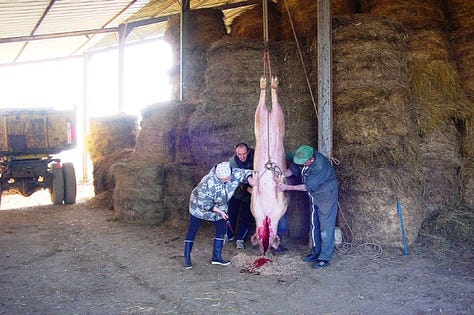
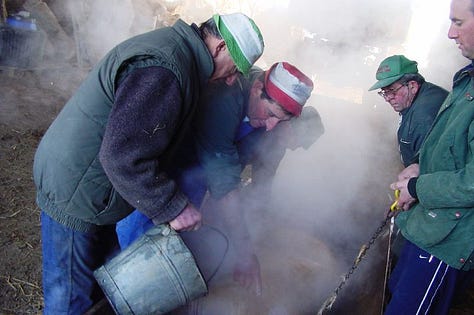
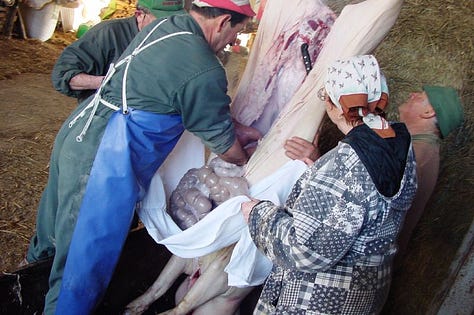
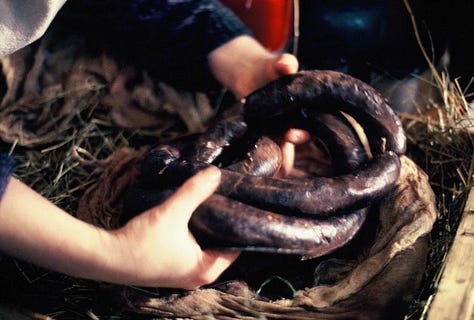
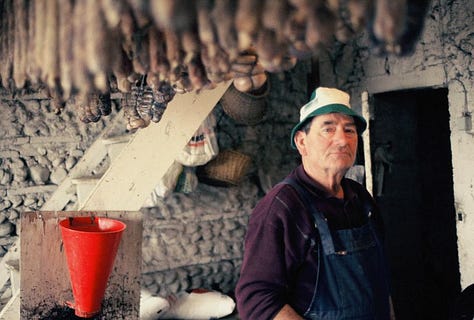
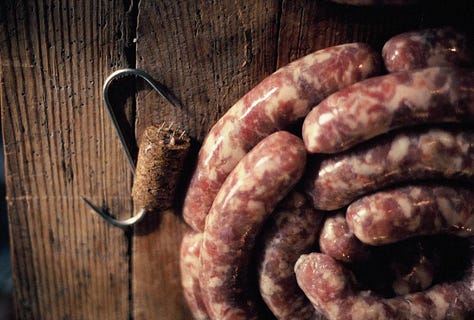
Continued Education- Seed to Sausage with the Chapolards. 2006-2019
This slow growth in learning over the next decade-plus was built on a foundation of everyday recipes and farm-based sustainability. Although I had met and visited the farm Baradieu in 1997, it wasn’t until after 2000 that I began to work alongside the Chapolard family on their dedicated pig farm, learning what I dubbed the “Seed-to-Sausage” approach of whole carcass butchery and charcuterie à la Française.By 2010. Beginning in 2009, I developed a Butchery and Charcuterie program here at Camont, created the Grrls Meat Camp (now rebranded as Women’s Good Meat Network), and established a diploma course in Butchery for the School of Artisan Food in the UK.
In addition to receiving hundreds of passionate chefs, butchers, and farmers here at Camont, I traveled the globe to teach in schools, restaurants, and farms in the USA, Mexico, Australia, and Japan. Dominique and Christian Chapolard were my willing cohorts and dedicated to passing on all aspects of farm life, from the working day two-hour lunches to the early Market Day preparations. Like a well-raised charcuterie pig (at least 12 months old), this sort of learning and teaching takes time. There are no instant books or simple recipes, but as Dom would say, it requires a hundred pigs to get the feel for the knife, the meat, and the salt. An investment in learning that would last a lifetime. And there will be more about this time soon.
But now it is January again. The neighbor’s Winter Pig is still King. I no longer teach in person, but reflecting on all I learned inspires me to collaborate on an online course and another book to continue transmitting this information based on nearly 30 years of practice. As I write these memories and thoughts of how I became an ‘expert’ in a niche field in a narrow-focus gastronomic world, I look even further back to how it started. Next, I’ll take you back to when I learned what that first pig had to teach me.
What’s Next on Finding France:
“My First Pig,” is the first thing I wrote (in 2006) about those early “Back to the Land” 1970s days and my first encounter with growing, cooking, and eating your own meat.
Recipes for some of the best French pork dishes created for Going Whole Hog- 2006 — a collaborative pre-conference website with Judy Witts Francini and Fergus Henderson. For paid subscribers.
Meet my farmer-teachers
A Special Cooking Class Video for paid subscribers.
Finding France: A Culinary Memoir is an edible tale of a young traveling cook who gets stuck on a barge in France and stays to become a wise old woman with a head full of ideas on French food and cooking. Kate Hill—cook, teacher, mentor, and author—invites you into her world of French food as learned over three dozen years of practice in the rural farmlands of Gascony. Read more here.
Kate Hill is the author of over a dozen cookbooks, including A Culinary Journey in Gascony, Cassoulet: A French Obsession, and A Gascon Year Series of 12 recipe and story volumes (available here). Published in America’s Best Food Writing 2019, curated by Samin Nosrat, Kate Hill has written for Saveur Magazine and The Los Angeles Times. Kate and her cooking, butchery, and charcuterie programs have been featured in Bon Appétit, Food and Wine, Condé Nast Traveler, The Washington Post, The New York Times, Boston Globe, Faire magazine, My French Country Home, and countless websites.
The Relais de Camont is in Gascony, Southwest France. Over the last 30 years, many artists and writers, photographers, filmmakers, and dreamers have found their inspiration at Camont, Kate Hill’s home in Gascony, France. In 2022, Kate opened the Relais de Camont and studio Cabane as writers’ rooms and creative residency for those seeking a less structured yet productive environment.
relaisdecamont.com









Hello Kate, I read this while drinking my morning coffee. Later this morning our neighbour and some of my wife's family, will slaughter pigs that will be spit roasted tomorrow (Saturday), and consumed at family feasts on Sunday which is Serbian Orthodox Christmas. How you tell the story of the "Winter Pig" mirrors exactly what happens here in the village where I live. Nothing goes to waste. The skills are passed down through generations. Bests from an unusually warm Northern Bosnia and Herzegovina, David
I’m a farm girl born and bred. and pigs have always been part of my life. I still find it hard to connect the animal with the meat, always a complicated link, even when you know they’ve had a good life. It gives you much more pause and respect for what’s on your plate when you truly understand where it’s come from.
We shared a winter pig with our neighbours here in France and spent a day with working alongside them and the butchers to make sausages and pâté , jarred pork and traditional sarthoise Rilettes. I was processed jars of terrine and pâté into the night! We gladly gave up our trotters and ear for a bit more meat for mincing though, we aren’t quite as nose-to-tail as we should be I’m afraid.